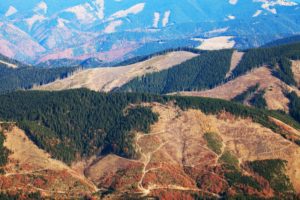What we ask of trees
 From my window seat while flying into Portland, Oregon in June, I was able to capture this shot. The many small, light patches seen in this photo are forested areas denuded of trees. These are parcels of forest land used for the growing of monocultures of trees for wood production. (These patches are on a cycle of clear cutting and re-planting.) Had our altitude over this area been much lower, we would have seen something similar to what the second photo shows.
From my window seat while flying into Portland, Oregon in June, I was able to capture this shot. The many small, light patches seen in this photo are forested areas denuded of trees. These are parcels of forest land used for the growing of monocultures of trees for wood production. (These patches are on a cycle of clear cutting and re-planting.) Had our altitude over this area been much lower, we would have seen something similar to what the second photo shows.
Oregon is the nation’s #1 producer of lumber. The majority of land used for lumber production is under  private ownership. The livelihood of many Oregonians depends on this industry. When we purchase any of these tree products (please open the highlighted link) we assist Oregonians, and residents in some other wood-producing states, in earning a livelihood.
private ownership. The livelihood of many Oregonians depends on this industry. When we purchase any of these tree products (please open the highlighted link) we assist Oregonians, and residents in some other wood-producing states, in earning a livelihood.
Many arguable reasons exist for why forest usage for lumber is preferable to uses for other development and commercial interests. You see, in the last 150+ years we have reasoned our way into altering land and overruling the laws of nature to meet our growing needs and interests. And since turning back the clock is either impossible, inconceivable or catastrophic for many people, the options we now face usually offer only varying degrees of damage to natural systems.
Why is this a topic of interest to the Cavity Conservation Initiative? Because this degree of fragmentation and loss of forests for wood production and other commercial purposes greatly reduces natural habitat. It therefore threatens populations of birds and wildlife and the viability of ecosystems. It also results in the elimination or severe reduction of dead trees for cavity nesting birds.
There are experienced professionals that are better qualified to address mitigation strategies for these challenges. However, it requires the ordinary citizen, you and I, to first be aware that forest fragmentation and habitat loss occurs not only because of our population growth. According to the Forest Products Commission, in just one year the average American consumes enough wood and paper to make up a tree 100 feet tall and 16 inches in diameter. This means that forest fragmentation for lumber production is also hastened by what we put in our shopping carts. It continues in our readiness to discard rather than repair, and our insufficient habit of reusing and recycling products. And it is linked with our loudening cry for outdoor recreation opportunities at the expense of natural systems. It sometimes takes a bird’s eye view from the window of an airplane to convey what we cannot see from our kitchens.


Connect
Connect with us on the following social media platforms.